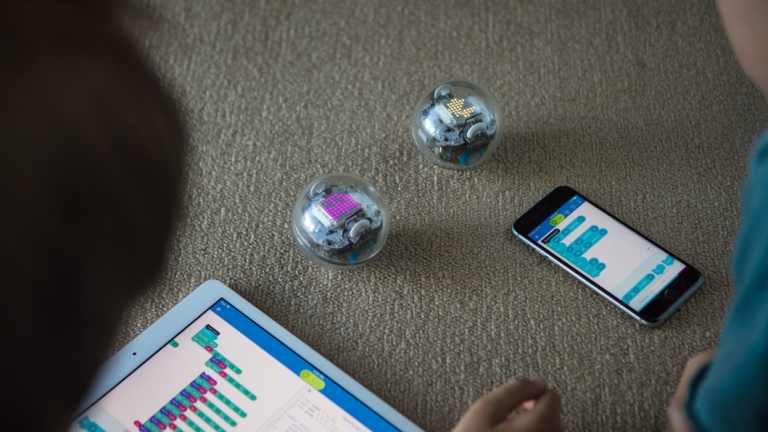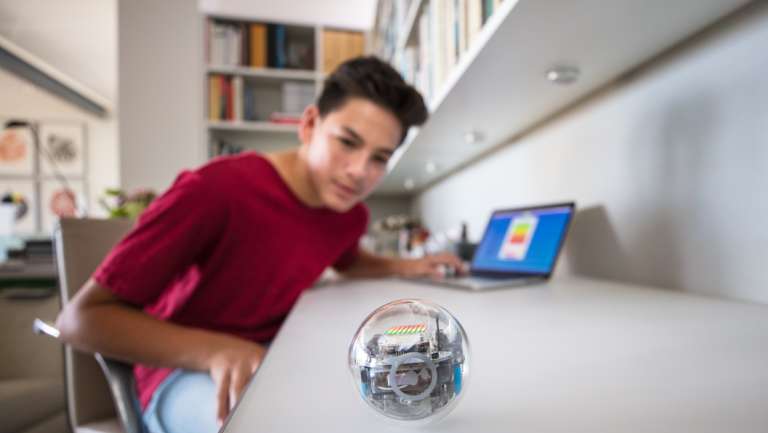
The Bolt is actually the successor to Sphero's SPRK+, which is basically a transparent version of the Sphero 2.0 aimed specifically at the education market. The fascinating view of its internal workings helps inspire enquiring minds.
It's worth noting that the Bolt is intended more for classrooms than individual home users. It lacks access to a few of the fun Sphero apps, but in return adds more flexibility for those who like to tinker under the bonnet.
Up to speed
At $249.99 the Bolt is the most expensive option in the Sphero range, but it adds a few new features that help justify the price tag and give it staying power.
For starters, the battery life has doubled to two hours and the little ball can now match the Sphero 2.0's swift 7 metres per second top speed. Sphero has also added an infrared port, which lets a fleet of Bolts interact with each other, although this is obviously more useful at school.

With multiple Bolts, you can get a whole fleet working together.
The biggest change the addition of a large 8x8 pixel colour LED display, which is also fully programmable. By default it shows basic icons and information, but you can incorporate it into your programs to display simple messages and animations.
Get behind the wheel
So what can you do with the Bolt? Unfortunately the Sphero Edu app's driving controls are pretty basic if you just want to race it around on the floor like a remote control car.
The Bolt becomes much more interesting when you switch across to the app's Programs tab. Here you can access a text or block-style programming interface which lets you control movement, lights and sounds; the sounds coming from your device, not the Sphero itself.
You can also use basic maths functions to create program logic, as well as tap into onboard sensors like the gyroscope, compass, accelerometer and ambient light sensor; even viewing a live data feed.
Output from the sensors can trigger events, such as changing colour as the Bolt accelerates, switching direction when it bumps into something or running away when you shine a torch on it.
The beauty of all this is that it brings programming off the screen and out into the real world, not only making programming more interesting and interactive but also giving kids an appreciation for electronics.

The Bolt's transparent body gives insight into what's happening inside.
Up to scratch
The Sphero Edu app offers a great range of programs to get you started and help you master the Bolt's different features, working up to complex tasks like navigating through a maze. You can also modify existing programs, create your own from scratch and share them with the Sphero community.
The latest Sphero Edu app update is built on the fantastic student-friendly Scratch modular programming environment, plus it supports JavaScript. This kind of future-proofing ensures the Bolt has plenty of flexibility when your budding programmer is ready to move onto more advanced projects.
Loading
While Scratch is built into the app, it's important to note that you can't actually link the Bolt to your Scratch account or import programs. Instead, you need to write Scratch applications from scratch within Sphero Edu.
Unfortunately you can't use the Bolt with all of the other Sphero apps, but thankfully it does work with the Sphero Play app which features a better driving interface along with a few games. Keep in mind you can use the Sphero Edu app with any of the Sphero robots, including the $80 Sphero Mini, so it's worth weighing up your options.
So what's the verdict?
As educational toys go the Sphero Bolt is hard to beat. The addition of the colour display certainly helps make the Bolt more engaging and interactive, while the extended battery life gives it real staying power.
These are important when you're spending this kind of money, as you don't want kids to grow bored with it after a few weeks and leave it on the shelf.
To be fair, if you're looking primarily looking for a fun toy to zip around the house then your money in probably better spent on a little remote control car or drone. The Sphero Bolt is aimed at kids who want to understand what makes things tick.
Adam Turner is an award-winning Australian technology journalist and co-host of weekly podcast Vertical Hold: Behind The Tech News.









 Add Category
Add Category